Jake Adelstein's Blog, page 84
April 6, 2011
Review: People Who Eat Darkness: The Fate of Lucie Blackman
Jake has done an honest and intriguing review of journalist Richard Lloyd Parry's People Who Eat Darkness: The Fate of Lucie Blackman over at Literary Review. Partial transcript below.
 When the disappearance of Lucie Blackman made the news, I was covering it as a reporter for the Yomiuri Shimbun, Japan's largest newspaper. By necessity rather than by choice, I was already familiar with the darker side of the country: I had spent 1999 to 2000 as a police reporter assigned to the 4th District, home of Japan's largest adult entertainment area, Kabukicho. Despite being from different papers, Richard Lloyd Parry and I worked the story together, exchanging information, contacts and tips. There was a chance that Lucie might still be alive, being held captive somewhere. The hope that reporting on it might make a difference superseded any journalistic rivalry. Now Parry has written a compelling book about the depravity of man, the difficult pursuit of justice, and how we deal with the wrongful deaths of those whom we loved.
When the disappearance of Lucie Blackman made the news, I was covering it as a reporter for the Yomiuri Shimbun, Japan's largest newspaper. By necessity rather than by choice, I was already familiar with the darker side of the country: I had spent 1999 to 2000 as a police reporter assigned to the 4th District, home of Japan's largest adult entertainment area, Kabukicho. Despite being from different papers, Richard Lloyd Parry and I worked the story together, exchanging information, contacts and tips. There was a chance that Lucie might still be alive, being held captive somewhere. The hope that reporting on it might make a difference superseded any journalistic rivalry. Now Parry has written a compelling book about the depravity of man, the difficult pursuit of justice, and how we deal with the wrongful deaths of those whom we loved.
Lucie, a young English woman, came to Japan to have fun and make money as a hostess in order to pay off her debts. She never went home. Her alleged killer, Joji Obara, is a clever man and a graduate of the law department of an elite Japanese university. I write 'alleged' because, despite all the circumstantial evidence that he was responsible for her death, the Japanese courts have only convicted him of dismembering her corpse. The charges were of rape resulting in death, but they have not yet been proven to the satisfaction of the judiciary. Obara knows that without a full confession, the Japanese police are handicapped, and prosecutors loathe such a case. He also knew enough of the law to prey on foreign hostesses. Hostessing is not allowed on foreign visas. If foreign hostesses go to the police as victims of sexual assault, they themselves are arrested and often deported, and no charges are generally brought against their assailants. (For years, human traffickers in Japan exploited this same fact.)
Every year, roughly 80,000 people go missing in Japan. The police don't investigate each disappearance, or even a significant fraction of them. Perhaps if Tim Blackman, Lucie's father, hadn't raised hell, the case would never have been seriously investigated. But once the Tokyo Police realised that this was not just another missing persons case, they pursued it with vigour and determination. While the police are generally treated fairly in the book, Parry implies that they were uninterested in the case, and this is not so.
April 4, 2011
The jury is in: Japan's new jury system is a farce.
This news story slipped under my large nose in the last few days of earth-shaking quake related news. On March 30th (2011) the Tokyo High Court overturned the not-guilty verdict of a 60 year-old office worker accused of smuggling in meth-amphetamines and other crimes. He was the first person to be found completely innocent under the new lay-jury system to have his not-guilty conviction overturned. He was found innocent in June of 2010. This time the prosecutor friendly court, which was not burdened with a jury, sentenced him to ten years of hard labor and a fine of six million yen.
In Japan, the lay-jury system, which pairs civilians with a judge or judges, was supposed to put a check on prosecutorial abuse and judicial arrogance by involving ordinary citizens in the process so that a more reasonable and fair verdict could be given. (Japan has a 99% conviction rate for criminal cases*). Unfortunately, in Japan de facto double jeopardy exists and on the flimsiest of claims the prosecution can appeal a verdict, so in reality, you can be tried for the same crime twice, even three or four times. Considering the unlikely odds of ever being found innocent, this makes actually walking away free after being prosecuted about as probable as TEPCO getting the Fukushima Nuclear Reactor working again. While the first trial in major cases may be held in front of a lay-jury, the appeal is your standard one judge court or panel of judges court.
The Tokyo High Court ruled that the defendant's claim to not knowing he was carrying drugs was not credible. However, one has to wonder how credible the prosecution is in Japan after one of their ace prosecutors was recently arrested and charged for forging evidence. Justice in Japan is a long way off. I suppose that in time of instability like these days, we should be happy that the Japanese criminal justice system still functions on the basic principle we've all come to know and love in Japan: presumed guilty until proven guilty.
*It should be noted that the conviction rate in Japan is only 99% because prosecutors will only take slam dunk cases. According to researchers like David Johnson, author of The Japanese Way of Justice many cases brought to the prosecutors are never pursued or "suspended" in perpetuity. Our legal philosopher and ace reporter, Stephanie Nakajima, will be doing a follow-up on this story in the near future.

The Japanese Way Of Justice by David Johnson is still an amazing treatise on the power of the prosecution in Japan's legal system.
April 3, 2011
The big question: Who gave TEPCO permission to use plutonium at the Reactor #3, when was permission granted, and why?
Things have not been going well for TEPCO (東京電力)ever since the 9.0 magnitude earthquake that killed thousands of people and left thousand more missing. It shook up Japan and especially TEPCO seemed ill-prepared for it. In fact, the company has such a long history of negligence, labor abuse, incompetence, and subterfuge, that it's not surprising the police are already investigating the firm for professional negligence resulting in injury and/or death.
What is surprising is that at least one of the reactors TEPCO was using plutonium mixed fuel when the earthquake hit. It's a surprise because previous governor Eisaku Sato had reportedly rescinded the firm's permission to use the dangerous materials. He took the permission away in September of 2002 when TEPCO's cover-up of malfunctions at their plants had become national news. This is from a Japan Times story on September 9th, 2003.
TEPCo had planned to start using uranium-plutonium mixed oxide fuel at the No. 3 reactor, in line with the government's plan to promote the MOX program as a key component of a nuclear fuel cycle. But governor Sato (Eisaku) said in September that he would rescind his earlier approval to accept the MOX program following the scandal. He noted that the conditions for the consent to go ahead with the project had "disappeared."
When did this consent mysteriously reappear? TEPCO began using MOX in September of 2010. We know that. What we don't know is who gave TEPCO permission to use MOX, when and why? Does the current governor, Yuhei Sato (佐藤雄平知事)know the details? Has anyone spoken to previous trouble-some governor Sato Eisaku? (佐藤栄佐久氏)He was forced out of power for allegedly being involved in political corruption. Former governor Sato has always claimed that the case against him was a frame-up, orchestrated by political powers and the prosecution. It's probably just a wild coincidence but allegedly one of the prosecution team that made the case against the governor was recently arrested and prosecuted himself for forging evidence this year.
Almost makes you believe in conspiracy theories. Almost.
I can't seem to find a newspaper article announcing that TEPCO had been given permission to began using plutonium at its reactors. We know they started using MOX before the earthquake. But when did they get permission? Who gave it to them? Perhaps, I'm just missing the right search word. If you, gentle reader, can find the announcement, let me know. Perhaps previous Fukushima Prefecture Governor Eisaku Sato never really rescinded permission. There are many possibilities. It would be nice to have the answer. It would be nice if someone asked TEPCO the question.
The big question: Who gave TEPCO permission to use plutonium at the reactors, when, and why?
Things have not been going well for TEPCO (東京電力)ever since the 9.0 magnitude earthquake that killed thousands of people and left thousand more missing. It shook up Japan and especially TEPCO seemed ill-prepared for it. In fact, the company has such a long history of negligence, labor abuse, incompetence, and subterfuge, that it's not surprising the police are already investigating the firm for professional negligence resulting in injury and/or death.
What is surprising is that at least one of the reactors TEPCO was using plutonium mixed fuel when the earthquake hit. It's a surprise because previous governor Eisaku Sato had reportedly rescinded the firm's permission to use the dangerous materials. He took the permission away in September of 2002 when TEPCO's cover-up of malfunctions at their plants had become national news. This is from a Japan Times story on September 9th, 2003.
TEPCo had planned to start using uranium-plutonium mixed oxide fuel at the No. 3 reactor, in line with the government's plan to promote the MOX program as a key component of a nuclear fuel cycle. But governor Sato (Eisaku) said in September that he would rescind his earlier approval to accept the MOX program following the scandal. He noted that the conditions for the consent to go ahead with the project had "disappeared."
When did this consent mysteriously reappear? Who gave TEPCO permission to use MOX, when and why? Does the current governor, Yuhei Sato (佐藤雄平知事)know the details? Has anyone spoken to previous trouble-some governor Sato Eisaku? (佐藤栄佐久氏)He was forced out of power for allegedly being involved in political corruption. Former governor Sato has always claimed that the case against him was a frame-up, orchestrated by political powers and the prosecution. It's probably just a wild coincidence but allegedly one of the prosecution team that made the case against the governor was recently arrested and prosecuted himself for forging evidence this year.
Almost makes you believe in conspiracy theories. Almost.
I can't seem to find a newspaper article announcing that TEPCO had been given permission to began using plutonium at its reactors. We know they started using MOX before the earthquake. But when did they get permission? Who gave it to them? Perhaps, I'm just missing the right search word. If you, gentle reader, can find the announcement, let me know. Perhaps previous Fukushima Prefecture Governor Eisaku Sato never really rescinded permission. There are many possibilities. It would be nice to have the answer. It would be nice if someone asked TEPCO the question.
April 1, 2011
Nuclear Ginza: Japan's secret at-risk labor force and the Fukushima disaster
Back in 1995, the UK's Channel 4 produced a 30-minute documentary on Japan's nuclear industry and how they use disadvantaged people, including burakumin and other day laborers, to do manual labor inside their power plants. And by inside, I mean inside. Some were forced to work right next to the room where the core was kept, in the dark and drenched in sweat; one man tells how he was forced to mop up radioactive water with towels.
Part 1
Part 2
Part 3
(via The Atomic Age, thank you to Shihoku Fujiwara of Polaris Project for the link)
One would like to think that things have changed over the years, but even now in Fukushima, reports are being published that tell how people are being lured with offers of up to ¥400,000 per day to work at the nuclear reactors–many of whom are victims of the tsunami. Because of high radiation levels the amount of time each person can spend inside is limited. TEPCO confirms they're working with outside agencies to secure enough workers to keep operations running, but refused to comment on how much each person is being paid.
March 31, 2011
The manga that predicted nuclear meltdown
There's been a number of postponements and cancellations in the Japanese entertainment world since the March 11 Tohoku Earthquake. Many are out of a sense of respect, some are due to logistics, but Men's Cyzo recently brought to light one manga that's been temporarily shelved due to a more macabre connection…
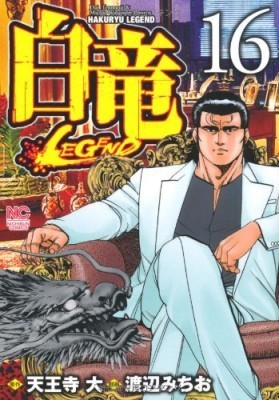
Shirakawa Tatsuya, the nicest yakuza on the block
Yakuza manga Hakuryu Legend (白竜〜LEGEND, published by Nihon Bungei-sha) tells the story of Shirakawa Tatsuya, a gangster whose cool, calculating yakuza nature is counterbalanced with a kindness so warm that children love him. The manga covers the typical gammut of yakuza plot lines: turf wars, fights, etc., but has also featured some rather unconventional topics, like the dubious transactions involved in constructing an amusement park, or the dark side of the medical profession.
But the bizarre reality of Hakuryu Legend's most recent story arc, "Atomic Mafia" (原子力マフィア編) may have been its undoing. In the March 24 edition, released on the day of the earthquake, Shirakawa and his crew are brought to a beach by a newspaper a reporter, a nuclear power plant looming in the background. Here, they're told by the man about the shadiness of one "Toto Denryoku" power company and their nuclear energy.
Despite the fact that the manga was penned before the March 11 earthquake, and certainly before the Fukushima reactor accidents, the larger-than-life dialogue rings eerily true, even if not all of it is accurate:
"There's been a lot of accidents happening inside the reactor that never get leaked to the press."
"Toto Denryoku knows how to use money and political power to keep everything hidden!"
"The workings of the reactor are 15 years behind the technology in chemical manufacturing plants."
"The reactors have been patched together by a number of different subcontractors.."
"And on top of that, the construction is really sloppy!"
"If the main workings of the reactor were to be blown off, you'd have an accident on the scale of Chernobyl!!"
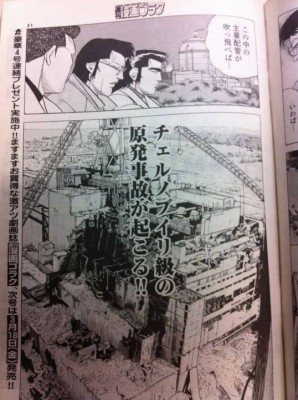
It would seem like fiction in any other situation...
The manga has unfortunately joined the long list of cancellations brought on by the Tohoku Earthquake, including Yakuza: Of the End, Disaster Report 4: Summer Memories (a game that opens with an earthquake hitting a major Japanese city), a number of anime and manga, shows by The National and other artists, Tokyo Bay Fireworks, even the Sanja Matsuri. According to Cyzo, there's been considerable protest raised on the Internet, with Hakuryu fans eager to get their hands on more of the comic, and perhaps glimpses of the future. The publisher has said they would consider bringing the manga back to Weekly Manga Goraku once a suitable amount of time has passed, but added that there's always the possibility it could be released in tankobon form by a different company if independent editors stepped in.
This isn't the first time Hakuryu has pre-empted reality. Before the "Atomic Mafia" arc, there had been pages dedicated to the rampant baseball gambling in the sumo world, and to yakuza fixing matches–before the news came out last summer. We can only stipulate on what kind of insight manga-ka Tennoji Dai and Watanabe Michio may have into the organised crime world…
March 30, 2011
Years of Disaster Drills Prevents Tsunami Deaths At Iwate Prefecture Junior High and Elementary Schools
Despite the fact that Unosumai Elementary School in Iwate-ken was engulfed by a tsunami (津波・tidal-wave), every one of the 350 students who were in the building at the time managed to escape, according to an article in the Asahi Shogakusei Shinbun published on March 24th.
When the ground started shaking, they initially all ran to the 3rd floor of their school. However, when they saw the students in the middle school next door congregating in the playground, without waiting for instruction from their teachers, they ran down the stairs, met up with the 212 middle school students, and all together ran one kilometer to a nursing home on higher ground. From the safety of the hill, they watched the tsunami swallow up their schools. 
The site of both schools, approximately 130 miles (or 210 kilometers) north of Sendai
Both schools are situated on Ootsuchi Bay
Of the 3,000 junior high and elementary school students in the district, only five are missing, four of which were absent from school that day.
This school district had been particularly well-prepared. Teachers brought in hazard maps created using data from the 1993 Hokkaido tsunami and held disaster preparedness classes for the students. The principal of the elementary school credits the fortunate outcome to the young student's understanding of both the gravity of the situation and the immediate action required.
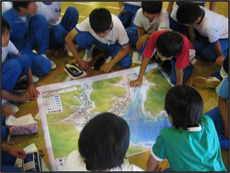
Unosumai Elementary School students in a class on tsunami procedure
Although students go through emergency drills a few times a year, they are taught to remember three main things:
1. If the ground starts shaking, don't go back to your house; run to high ground.
2. Don't necessarily follow the hazard map; examine the current situation, consult with others, and make the best judgement.
3. Help others.
The Asahi article suggests one bear in mind two other qualities of tsunami: first, even if the tremors felt are relatively minor, a large tsunami can still develop; and secondly, that a tsunami can come in not just one large wave, but several phases; so even if the water does recede, one should never quickly return to one's house for supplies or possessions.
Jake's note: These grade-schoolers were better prepared for disaster than the government of Japan. I wish we could replace Prime Minister Kan Naoto with the Unosumai School Principal.
March 29, 2011
Yakuza 4: Fact or Fiction? My review and discussion with IGN
The popular 龍が如く (Yakuza) video game series by Sega was released this March (2011). My kohai (後輩) and friend from my days at Sophia, Peer Schneider at IGN asked me to review the game for their website, checking for general accuracy, along with Daemon Hatfield, a senior editor. The game allows you to play as four characters: a benevolent loan shark, an escaped convict who killed 10 or more yakuza in a violent ramen shop blood bath (based on the actual Maebashi incident), a corrupt Vice Squad cop, and of course, the yakuza paragon of ninkyodo (任侠道-the noble way), Kazuma Kiryu, who has driven the series from the first edition. The four interwoven story-lines all come together before the game concludes. The 5th game in the series, Yakuza of The End, in which you get to save Kabukicho from zombie hordes is coming soon.
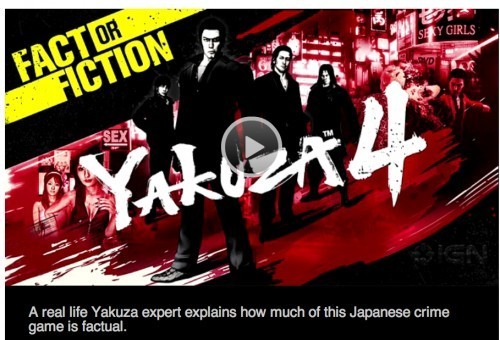
Yakuza 4: Fact or Fiction? A lot of both. A good game in its own right.
It was enjoyable playing four different characters, although honestly, I had to say I liked playing the loan shark the most. Maybe it's a Jewish thing. Ask one of my relatives, allegedly a Jewish mobster in his day. Maybe it's because I spent too many years covering the Kajiyama Susumu (Emperor of Loan Sharks) story. In reality, I've only known one loan shark who had any moral code at all. His was: don't bother the families of the debtor. You can beat him up, intimidate him, hound him for interest, but leave the family out. That's something, I guess.
I also liked playing as the morally challenged vice-cop. (Mmm…sort of felt like deja vu at points. Ahem.)
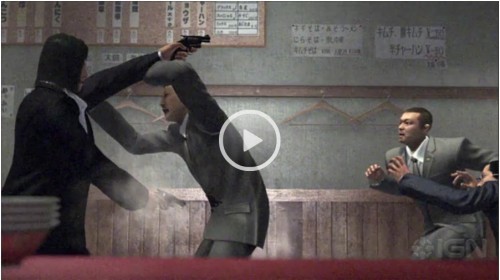
Ramen Shop Shoot-out Based on Maebashi Incident
The game is graphically violent and based on some real incidents. Unlike most of the fight scenes (unrealistic) in the game, the yakuza shot to death in this scene stay very dead. I imagine in Yakuza 5 they'd just come back to life as zombies. The cut scenes in the actual game are incredible; Kitano Takeshi could have directed them.
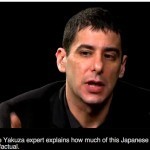
As I expound on the yakuza, you can see my vulcan ear. Really pointy.

Mr. Hatfield was a whiz with the controls, and a great host. I suck at video games.
It took some time getting used to the video review format but once I got over that, it was a very fun talk. I could have gone on for another fifteen minutes but they were kind enough to make me shut up.
Unlike the last hastily put together English version of the Yakuza games series, this one had surprisingly little cut out. The hostess clubs were there as well as the sexual massages parlors. There are many sub-adventures in the intricately mapped out Japanese underworld in this latest version of the series. The "fashion health massage" parlors are the rare mini-adventures in a very dark game that actually have a happy ending.
If you're interested in the yakuza, the Japanese police, loan sharking, or the underworld of Tokyo–the game is worth playing. The details are amazing and the story-line, while convoluted is compelling on its own. It smacks of conspiracy theory but then again Japan is such a strange country and the ties between politicians, entertainment, yakuza and major industries are so tight and complex–that what seems like a conspiracy theory sometimes turns out to be the truth. However, in this case, it's just a game.

In Yakuza 4, "Fashion Health Massage" is available with happy ending just like in the real Kabukicho.
Get ready to roll….and stop hoarding toilet paper, gas, etc. Let's all share!
Graphic designer Takamasa Matsumoto created a very colorful poster to discourage Tokyoites and people across Japan from hoarding toilet paper, gas, rice and the other essentials of daily life, urging everyone to share in consideration of people who really need supplies. The poster which he put up on his twitter feed @stam_mats2 has become a social media hit. Some bloggers have quibbled with his numbers but the sentiment is a heart-felt one and something to keep in mind. Personally, I brought mega rolls of toilet paper from the US before coming back to Japan, so I haven't felt a need to hoard it here. It's a little mysterious why toilet paper becomes such an object of desire in the midst of post-earthquake life but the hoarding of gasoline is not so surprising; it really is in short supply and causing problems. Thankfully, when we really need it, the vice-mobile (our nearly dead vintage black Mercedes Benz) runs on high-octane fuel which is available in ample supplies. Of course, the down-side of driving around in that gas guzzling monster, besides environmental guilt, is that we get pulled over by the police twice as often. There are disadvantages to employing an ex-yakuza boss as your bodyguard and driver when you're riding in the stereotypical yakuza car. He's still a yakuza on the official police records. At least the police are generally very courteous when they stop us.
Here is the original Japanese poster.
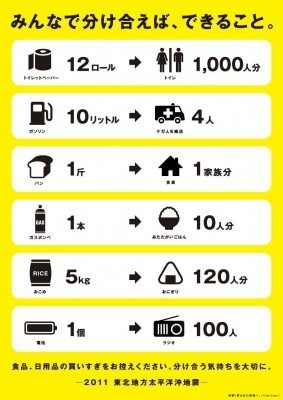
Let's stop hoarding and share poster by Takamasa Matsumoto in Japanese
Here is my English version of the same poster. Pardon the crudeness; I am not a graphic designer.
What we can accomplish if we share! (買い占め防止ポスター英訳)
Of course, it would be a shame to flush away the opportunity to comment on the silliness of hoarding toilet paper. WilliamBanzai7 (twitter @williambanzai7) was kind enough to give us this illustration which makes the point so eloquently. Snake, come back! Tokyo needs you.

SNAKE CHARMIN: ESCAPE FROM TOKIO!@williambanzai7
March 25, 2011
Japan's Darker Days: The 1923 Great Kanto Earthquake. Rumors ruined lives and they're starting again.
The people of Japan have impressed the world with their generally orderly and peaceful response to the earthquake, the tidal waves, and the nuclear disaster in Fukushima Prefecture. While there have been problems, there have been few reports of wide-spread looting or violence. Most people are patiently dealing with the problem, even in devastated areas. There have been runs on toilet paper and drinking water but for the most part things have gone smoothly. Rumored accounts of sexual assault at the shelters and other acts of violence are starting to come in but few are verifiable. The police did arrest one 40 year old construction worker who broke ranks at a line for gas and threatened a gas station attendant until his car was filled up. He drove off and was arrested later for the obvious: extortion (恐喝容疑). However, for the most part the average Japanese citizen's response to a trifecta of disasters has been a model of stoic calm and mutual consideration.
This wasn't the case after the 1923 Great Kanto Earthquake. Rumors were soon spread and propagated by the mass media that Koreans and other foreigners were running amuck, creating a hostile atmosphere in which untold numbers of Koreans and others were killed and brutalized. It did not speak well of the Japanese people at the time. Japan has not always been a peaceful nation and disasters do not turn all sinners into saints. The Asahi Shinbun, Japan's second largest newspaper today reports that wild rumors are already flying in the disaster stricken areas, including those of roving foreigner bandits (外国人窃盗団). Due to the disproportionate coverage the Japanese media gives to crimes by foreigners and an undercurrent of xenophobia in Japanese society, it'll only take one report of a group of foreigners committing crimes after the earthquake to quickly create an ugly mood. It would be nice if the Japanese press showed the restraint in reporting such events as they do in reporting on the professional negligence of TEPCO, one of the biggest media advertisers in Japan.
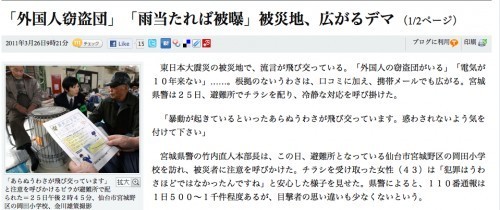
"Roving Bands Of Foreign Thieves". The Asahi Newspaper reports that groundless rumors are flying across Japan (March 26th)
However, there are signs of greater acceptance of foreigners in Japan and acknowledgement and/or acceptance of their role in Japanese society. The Sumiyoshi-kai, Japan's second largest crime group, reaching out to some foreigners to offer them places to stay was surprising. As is the March 26th story story in the Sankei Shinbun (産経新聞)which has the headline: "The US Forces In Japan: Heroes of The Reconstruction" (在日米軍 復興の英雄). Anyone who knows what a far-right, anti-American newspaper the Sankei Shinbun is on a normal day, should be shocked to see such a headline. In US terms, it's like Glen Beck saying, "I think Obama's health care policies make a lot of sense. I support him." You get the idea.
The following is reprinted from the book, The Dark Side: Infamous Japanese Crimes and Criminals (Kodansha International, 2001). Currently out of print. Mark Schreiber, the author of the book, was kind enough to give us permission to reprint the relevant section. It's a sobering read and it says a lot about how far Japan has come in the last few decades. Note: The Asahi Shinbun (朝日新聞)does touch upon the fate of foreigners in the Great Kanto earthquake within their article. (過去の震災では、1923年の関東大震災で「朝鮮人が暴動を起こす」とのデマが流れ、多数の朝鮮人が虐殺された。95年の阪神大震災では、大地震の再発や仮設住宅の入居者選定をめぐる流言が広がった.)
********************************
" The quake and its aftermath" by Mark Schreiber
Nineteen twenty-three, the 12th year of Taisho, is best remembered as the year of the Great Kanto Earthquake. When the quake struck just before noon on September 1, law enforcement suffered as much as the general population. Twenty-one of the city's police stations and 254 koban were seriously damaged or completely destroyed. Among the dead were 94 police officers and firemen, including the captain of the Honjo Aioi police station.
Tokyo's Kosuge Prison was devastated. The over 1,000 inmates were temporarily released on the honor system — a custom going back to feudal times. Amazingly, all of them returned, apparently out of a sense of obligation to the warden, Shirosuke Arima, who was known for his stern but fair treatment. In Yokohama, where the devastation was even greater, the local prison was not so fortunate. Its warden temporarily freed 1,131 prisoners on their own recognizance. Of these, 140 failed to return and the warden required assistance from the navy shore patrol. Later, naval ships were used to ferry several hundred convicts to temporary lodgings at Nagoya prison.
The mob lynchings of thousands of Koreans and smaller numbers of Chinese were anything but spontaneous. On September 3, Fumio Goto, a security official in the Interior Ministry, cabled outlying offices that Koreans were committing acts of arson and ordered them rounded up. The media, particularly the nationalist Hokkai Times, chimed in with inflammatory stories.
One of the first acts by newly appointed Prime Minister Gonnohyoe Yamamoto was a demand for the persecution to stop, but the damage had been done. The incident was to spur a young man named Daisuke Namba to fire a shots at then Crown Prince Regent Hirohito on December 27. He was found guilty of lese majeste and hanged a year later.
Rightists also took advantage of the confusion to kill scores of fellow Japanese, whom they viewed as "enemies" of the state. In the notorious "Kameido Incident" of September 3, Yoshitora Kawai, Keishichi Hirasawa and eight other labor activists were beheaded by cavalry troops based in Chiba.
Perhaps the best-known victim of the carnage was a 39-year-old anarchist named Sakae Osugi. One of the country's most flamboyant rebels, Osugi had recently stirred controversy with an autobiography in which he railed against the oppressiveness of family and society. He had just returned from a sojourn in France.
On September 16, a captain of the *kempeitai* (military police) named Masahiko Amakasu dispatched teams of soldiers to track down and apprehend Osugi. He was finally spotted around 5:30 p.m., waiting with his six-year-old nephew Munekazu as his wife, Ito Noe, 29, shopped for fruit near their house.
The three were driven to the military police compound at Kojimachi. Around 8:00 p.m. Osugi was taken into a conference room and seated. Amakasu later testified that he walked behind Osugi and locked his forearm across his throat in a judo stranglehold. It took about 10 minutes for Osugi to die of asphyxiation. The process was repeated shortly afterward with Ito. Two enlisted men then strangled the boy using a hand towel. That night, their bodies were wrapped in burlap, bound with rope and tossed down an unused well.
On September 20, doctors performed forensic autopsies on the victims. The report, only made public half a century later, noted that Osugi and his wife were also severely beaten before being strangled.
At his court martial in October, an unrepentant Amakasu delivered a rambling soliloquy on his motive for the slayings. "In just 50 or 60 years," he harangued, "our country has achieved the level of civilization that took 500 or 600 years in Western countries. If anarchists are allowed to oppose the ways of our sacred land, it will lead to the ruination of the Yamato race. [These people] are like parasites in the body of a lion, and I cannot allow them to carry on." The prosecutor at the trial was less than energetic in condemning Amakasu's crimes. After all, he conceded to the bench, these were "extraordinary times." Still, murder could not be disregarded; the prosecution requested a 15-year sentence. On Dec. 8, the military court sentenced Amakasu to a 10-year term of imprisonment. Sgt. Keijiro Mori received 3-year sentence. Two MPs under his command were acquitted because they acted on orders.
Amakasu was quietly paroled after two and a half years. After spending 18 months in France, he became director of a film production company in Manchuria and over the next decade engaged in a variety of intrigues. He committed suicide on August 20, 1945, to avoid capture by the Soviet army. Amakasu achieved posthumous film stardom of sorts. Played by composer Ryuichi Sakamoto, he was prominently featured in the 1987 Bertolucci film "The Last Emperor."





